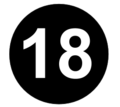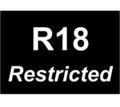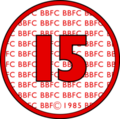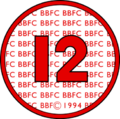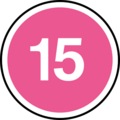History of British film certificates facts for kids
This article tells the story of how films in the UK get their age ratings.
These film ratings are decided by the British Board of Film Classification (BBFC). They have been doing this since 1912. Before that, there were no clear rules. Local councils often made up their own rules for films. For movies shown in cinemas, the BBFC doesn't have legal power on its own. Councils usually follow the BBFC's ratings, which makes them legally binding. Sometimes, a council might change a rating. They might make a film for older or younger viewers. They can also ban a film or rate films the BBFC hasn't seen.
Before 1985, there were no legal ratings for videos. The Video Recordings Act 1984 changed this. It made the BBFC rate almost every new video release. This was to decide the youngest age a person could buy or rent a video. In 2009, it was found that the 1984 Act had a problem. So, a new law, the Video Recordings Act 2010, was passed.
This article will show you how the BBFC's rating system has changed over time. In each section, italic text shows when a rating changed from the previous system.
Contents
- How Film Ratings Started
- 1912 to 1932: The First Ratings
- 1932 to 1951: Adding "Horrific"
- 1951 to 1970: The "X" Rating Arrives
- 1970 to 1982: More Age Categories
- 1982 to 1985: A Big Change to Ratings
- 1985 to 1989: Videos Get Ratings Too
- 1989 to 2002: The 12 and 12A Ratings
- 2002 to 2020: Modern Look and Changes
- 2019 to Present: New Look for Digital
- Special Certificates and Ratings
- See also
- Images for kids
How Film Ratings Started
1912 to 1932: The First Ratings
At first, there were only two simple advice ratings.
| Symbol | Name | What it Meant |
|---|---|---|
 |
Universal Exhibition | Good for everyone to watch. |
 |
Adult Audiences | More suited for grown-ups. |
After Ireland became independent in 1922, they started their own film rating office in 1923. It was first called the Irish Film Censor's Office. Later, in 2008, it was renamed the Irish Film Classification Office.
1932 to 1951: Adding "Horrific"
In 1932, a new rating called H (Horrific) was added. This was to warn parents about horror movies.
| Symbol | Name | What it Meant |
|---|---|---|
 |
Universal Exhibition | People of all ages could watch. |
 |
Adult Audiences | Kids under 12 needed a parent or guardian to watch. |
 |
Horrific | Only people aged 16 or older could watch. |
1951 to 1970: The "X" Rating Arrives
In 1950, a committee looked into film ratings. They suggested new ratings. Only one was chosen: the X (Explicit Content) certificate. This was the first time a rating was compulsory. It meant only people aged 16 and older could watch. This rating replaced the H certificate.
| Symbol | Name | What it Meant |
|---|---|---|
 |
Unrestricted | For everyone. |
 |
Adult Content | Kids under 12 needed an adult. |
 |
Explicit Content | No one under 16 allowed. |
1970 to 1982: More Age Categories
On July 1, 1970, the A rating was split into two. The old 'A' became a new advisory 'A'. This meant kids aged five or older could watch, but parents were warned about some content. A new AA rating was created for people aged 14 or older. Because of this, the X rating changed. It now meant only people aged 18 or older could watch.
1982 to 1985: A Big Change to Ratings
On November 1, 1982, the rating system was completely updated. Only the U rating stayed the same, but its meaning was slightly changed. The A rating was replaced by PG (Parental Guidance). This new PG rating was only advice. The AA rating's age limit went up by one year and was renamed 15. The X rating was renamed 18. A new R18 rating was also added. To show R18 films, cinemas had to be special members-only clubs. The new ratings also had different shapes for their symbols.
1985 to 1989: Videos Get Ratings Too
The Video Recordings Act 1984 made the BBFC legally responsible for rating all videos. The existing ratings were used and also got colors. A new Uc rating was added just for videos. It meant a video was especially good for young children to watch alone. If a video had a certain rating, people younger than that age could not buy or rent it. Shops that wanted to sell or rent R18 videos needed a special license.
1989 to 2002: The 12 and 12A Ratings
There was a big age gap between PG and 15. So, a 12 rating was added on August 1, 1989. At first, it was only for cinema movies. It didn't cover videos. The 12 rating for videos started on July 1, 1994. Before this, some films rated 12 in cinemas had to be rated 15 for video. Or, they might be cut to get a PG rating. For example, Uncle Buck was 12 in cinemas but 15 on video at first.
In 2002, the cinema 12 rating changed and was renamed 12A. This meant that kids under 12 could now watch 12A films if an adult (aged 18 or older) was with them. The BBFC still suggested that 12A films might not be suitable for kids under 12. The first film to get the 12A rating was The Bourne Identity. Other films already in cinemas, like Spider-Man, were also changed to 12A.
2002 to 2020: Modern Look and Changes
In September 2002, all the rating symbols got a new, modern look. They kept their main colors and shapes. The Uc rating was stopped in 2009. It was replaced by "BBFCInsight," which tells you if a film is "particularly suitable for pre-school children." However, older DVDs might still have the Uc rating. The advice for the U rating was updated. It now suggested parents check films for children under 4. For PG, it suggested checking for children under 8.
2019 to Present: New Look for Digital
The 12 symbol changed to the same color as the 12A symbol. The 15 symbol changed from white with red writing to a pink background with white writing. In October 2019, all the symbols were redesigned for digital streaming and cinema movies. However, physical videos (like DVDs) kept using the older symbols until April 2020. There was a time when both old and new symbols could be used. After October 5, 2020, all physical videos must use the new symbols by law. The "BBFCInsight" was replaced with "ratings info."
Special Certificates and Ratings
Sometimes, councils or trials use special ratings that are not standard BBFC ones.
| Symbol | Name | What it Meant |
|---|---|---|
| PG-12 | Good for those aged 12 and older (cinema only); kids under 12 can watch if with an adult.
This was a test rating used in Norwich from October 2001 to January 2002. All 12-rated films were shown as PG-12. This test helped lead to the 12A rating being created in 2002. After the Norwich test, some councils, like Tameside Council, used PG-12 for films like Spider-Man, even though the BBFC rated it 12. |
|
| 15A | Generally good for those aged 15 and over (cinema only); kids under 15 can watch if with an adult.
Belfast City Council used this special rating for The Batman (2022). This allowed children under 15 to watch the film in Belfast cinemas if an adult was with them. The BBFC had given the film a 15 rating. |
|
| Exempt or 'E certificate' | The 'E' symbol is not a BBFC age rating. It means the company releasing the video believes it doesn't need a rating under the Video Recordings Act 1984. This is usually for things like educational videos, music, or sports. |
See also
- BBFC
- 18 certificate
- R18 certificate
- Motion picture rating systems
Images for kids




























